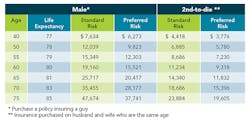Latest from Blackman
Sponsored
My original goal for this article was to begin an analysis of the proposed overhaul of the Internal Revenue Code and how to beat the new tax monster at his own game. No luck. Actually, no law. It's hard to believe that the GOP, with absolute voting control over both houses of Congress, has two separate versions of the new law — the House version and the Senate version.
Yes, there are differences. Significant differences. A large army of pundits has begun the "picky-picky attacks" on specific points in both versions. The lawmakers on the other side of the aisle are delighted.
The best I can see at the moment is "we are in the process," a long, drawn-out affair, with no light at the end of the tunnel.
Instead, let's take a look at a subject — life insurance — that will help you and your family no matter what the final new tax law looks like.
Why is life insurance such a powerful strategy to enrich our CONTRACTOR readers at the expense of the IRS? Because the Internal Revenue Code is very kind to every aspect of life insurance. Why? Because the insurance industry is very kind to the Washington politicians that keep the tax law favorable. Unfortunately, the law is complex and if you don’t use the law properly, the law will eat your lunch.
The rest of this article shows you how to take advantage of the current law (neither of the bills in Congress propose any changes to the treatment of life insurance). Actually, when you know how, it’s easy.
Let’s start by examining the very important, but little-known economics of life insurance. The following Schedule shows you the typical annual premium amount to buy a new (universal life) insurance policy with a $1 million death benefit.
Take a look at the Schedule to find your age (or close to your age). Three facts jump out at you:
1) Premiums become significantly higher as you age. (The lesson — invest in life insurance as soon as you can afford it.)
2) It pays to be healthy. “Preferred Risk” males get about a 20% discount compared to “Standard Risk” males.
3) Second-to-die insurance is a true bargain, receiving about a 40% discount and rising as you get older to over 50% at age 75.
Note: If you are healthy for your age, life insurance works to about age 83 for males, 86 for females and age 88 for second-to-die. Remember, female life expectancy is three to four years more than a male who is the same age, thus lowering female premiums.
Now let's look at some real-life examples.
Example #1. Insurance-funded buy/sell agreements
Warren (56) and his brother Bill (58) have an insurance-funded buy/sell agreement. Both are in excellent health. An audit of the policies showed that Bill’s policy would lapse at age 70 and Warren’s at age 69. My insurance guru was able to arrange for a tax-free exchange for each brother so the policies would be guaranteed to pay the death benefits ($2.1 million for each) no matter how long Warren or Bill might live (without any added premium cost). Nice!
Here’s a note of caution: We rarely find insurance-funded buy/sell agreements that have been properly drawn up. There are dozens of possibilities for expensive blunders — tax and otherwise (as above). Always get a second opinion.
Example #2. Life insurance no longer needed on husband.
Cal (59) and Cindy (55) are married. Cal has insurance on his life: death benefit of $788,000; cash surrender value (CSV) of $213,000; and an annual premium of $9,000. They are worth over $14 million (mostly cash or cash-like investments). Cal earns more each year than they spend, so they don’t really need single life insurance on Cal.
My network insurance consultant was able to use the $213,000 CSV, continuing the $9,000 annual premium to purchase a second-to-die policy with a $1.6 million death benefit — almost double the amount of the old insurance. Powerful!
Example #3. Using life insurance as a tax-advantaged investment.
Wendy, a 76-year-old widow, is worth over $12 million, mostly liquid investments. Her investment income far exceeds her lifestyle costs. Following is a wealth-increasing, two-step strategy.
Step #1. Wendy paid $2 million for a single-premium immediate annuity (means the insurance company will pay Wendy the same annuity dollar amount every year for as long as she lives).
Step #2. Wendy bought a $5.6 million insurance policy (actually owned by an ILIT, so the death benefit will go to her kids tax-free). How are the premiums paid? The annuity payments are used to pay the premiums. We turned $2 million (which would have been subject to estate tax) into $5.6 million (tax-free), guaranteed. Awesome!
To give you an example of all the possibilities for using life insurance to 1) increase your wealth without risk or 2) increasing your current policy’s death benefit without increasing premium cost, would take a huge book. So, I cornered my insurance guru and twisted his arm into agreeing to audit the insurance policies of readers of this column without any obligation. Or maybe you are just looking for a new policy to increase your current wealth without risk.
Send me (Irv) a fax (on your letterhead if in business) at 847/227-9008 along with a short note about your life insurance situation. Or email me ([email protected].) Please include all of your phone numbers: business, cell and home. Mark “Life Insurance” on your fax or email.
Irv Blackman, CPA and lawyer, is a retired partner of Blackman Kallick LLP and chairman emeritus of the New Century Bank, Chicago. He can be reached at 847/767-5296, email [email protected] or on the web at www.TaxSecretsOfTheWealthy.com.
Irving L. Blackman
Irv Blackman, CPA and lawyer, is a retired partner of Blackman Kallick LLP and chairman emeritus of the New Century Bank, both in Chicago. He can be reached at 847/674-5295, via e-mail or on the Web at: www.taxsecretsofthewealthy.com.



